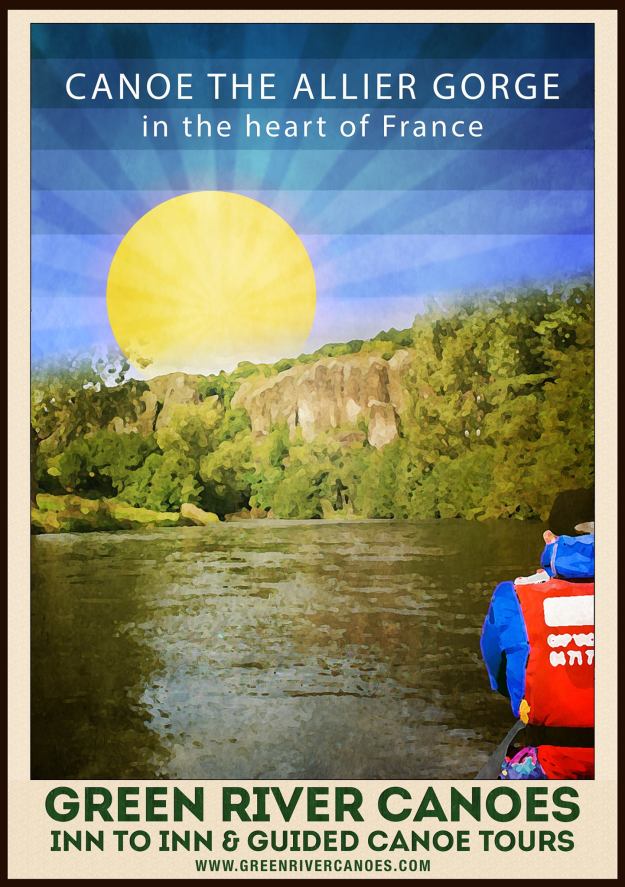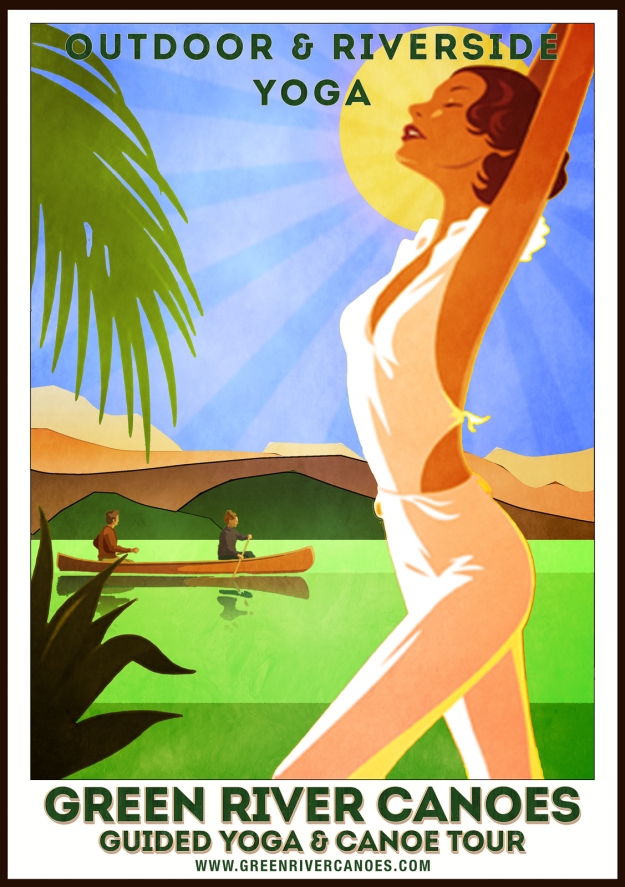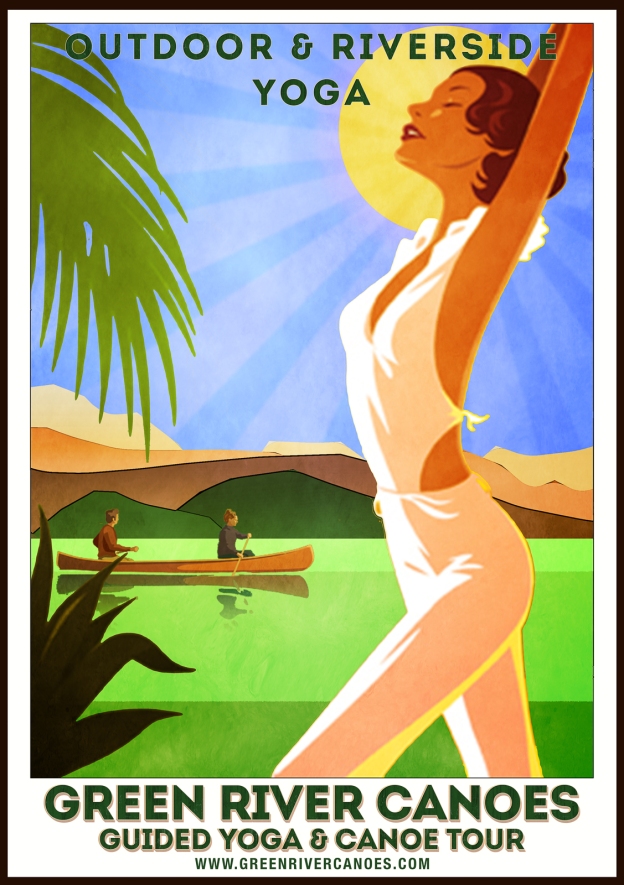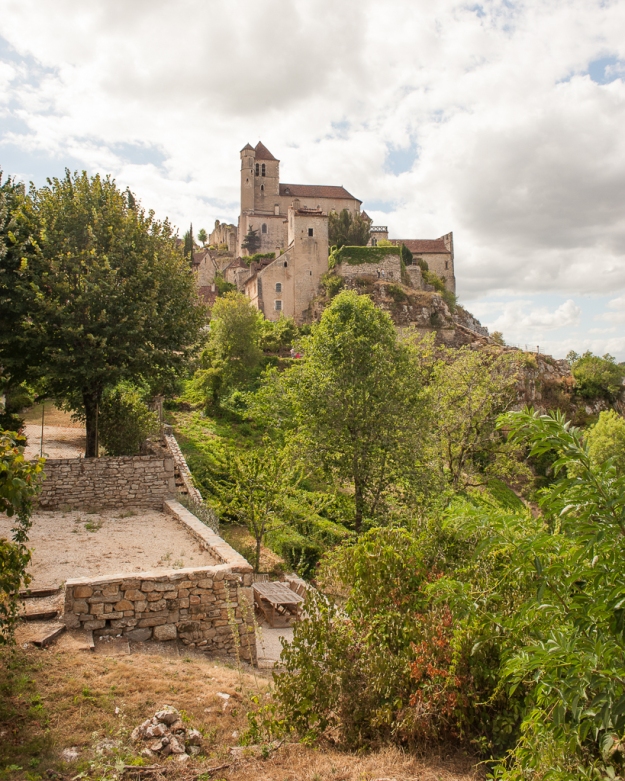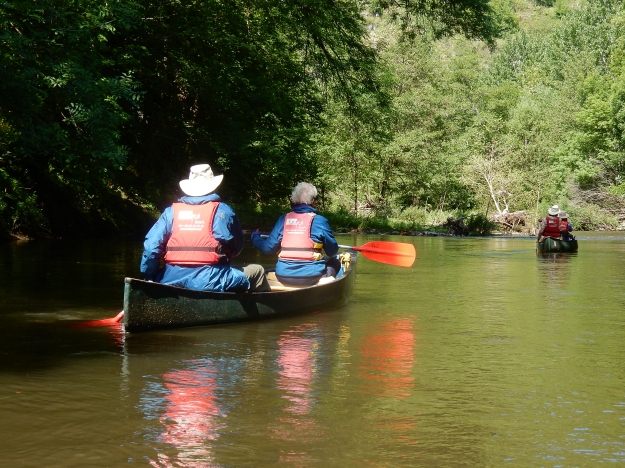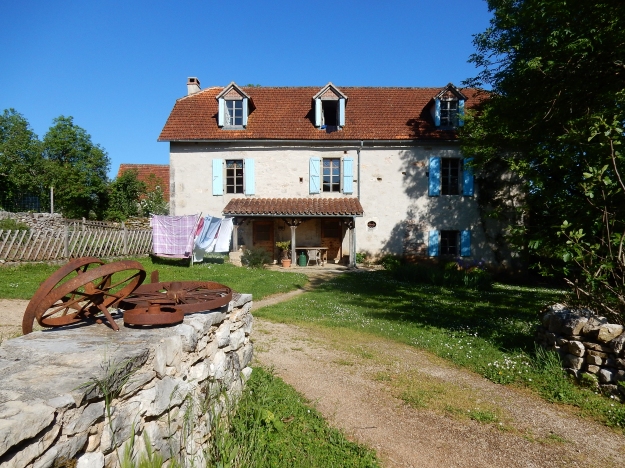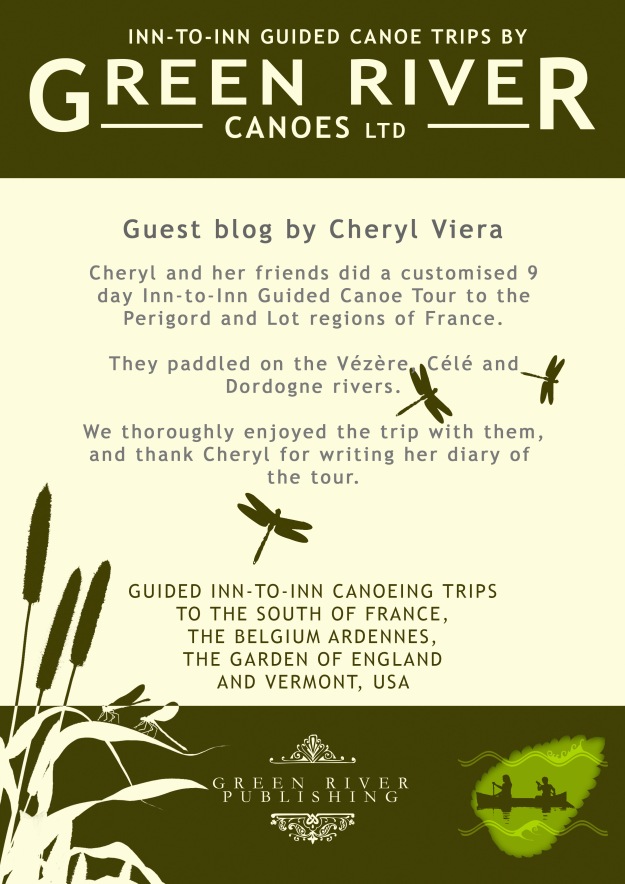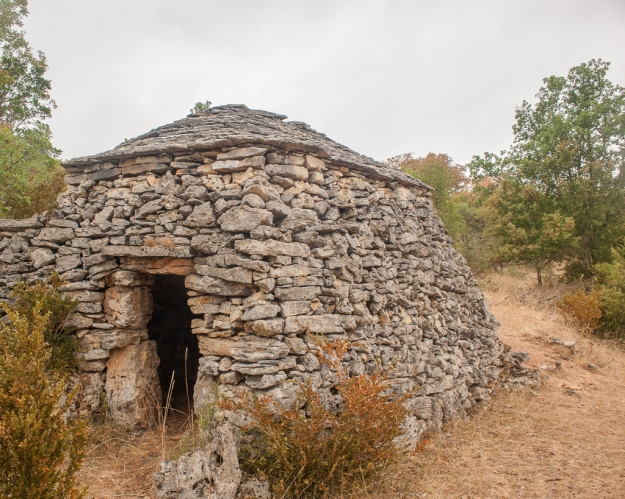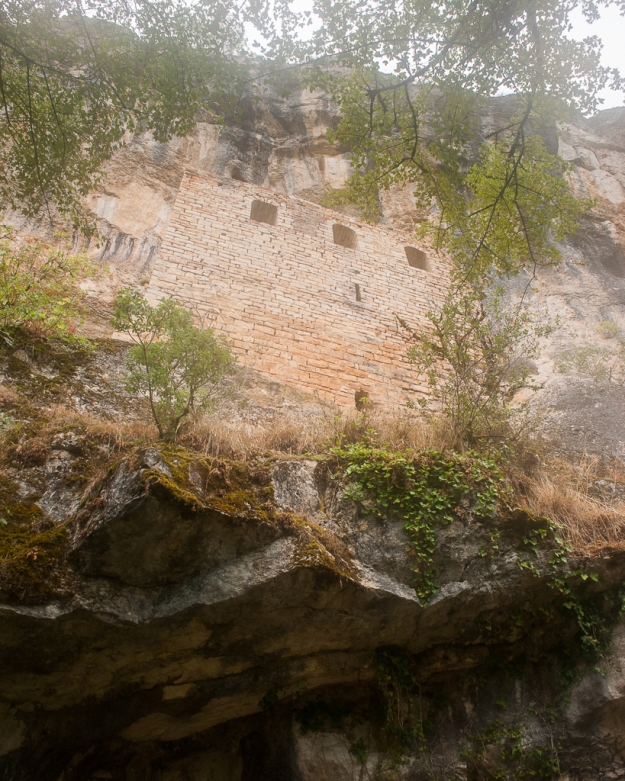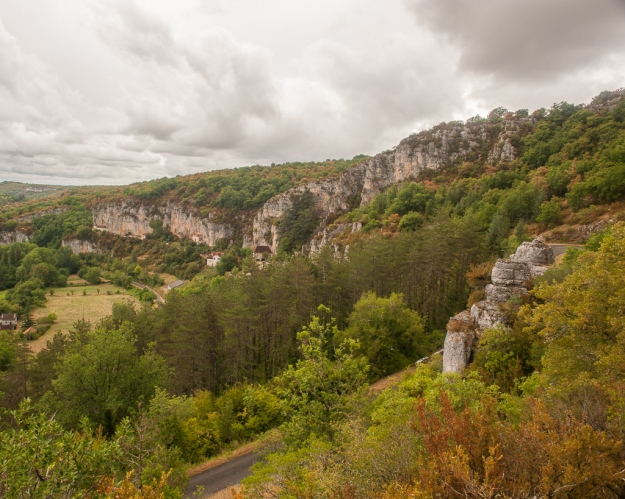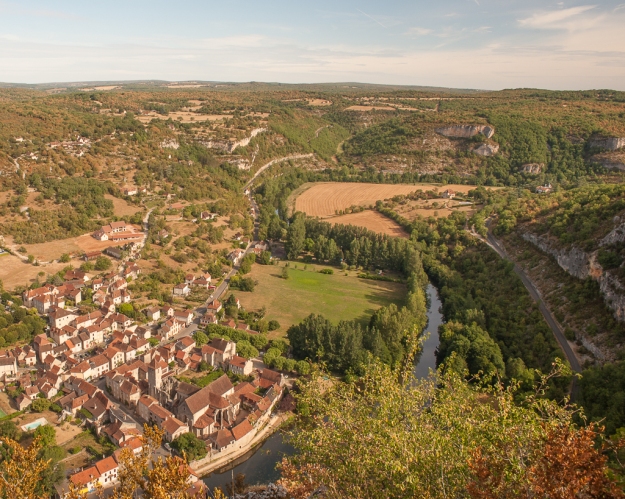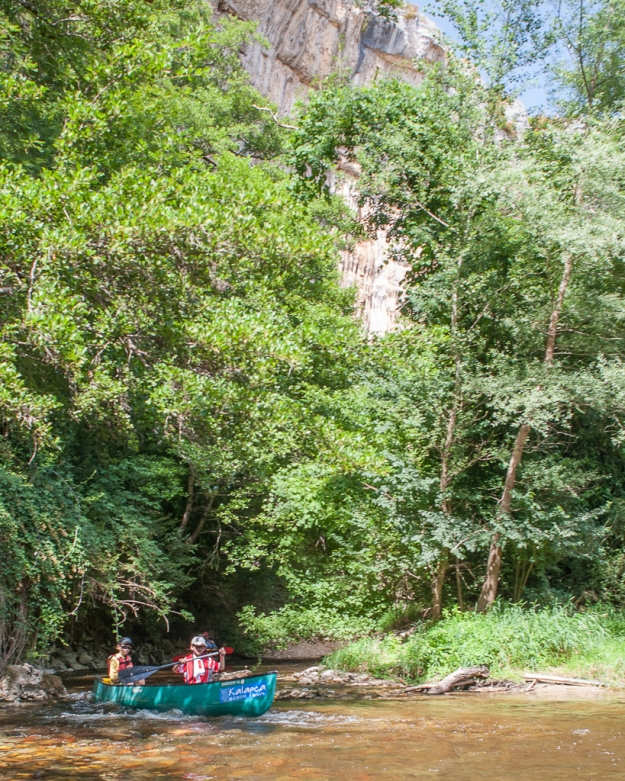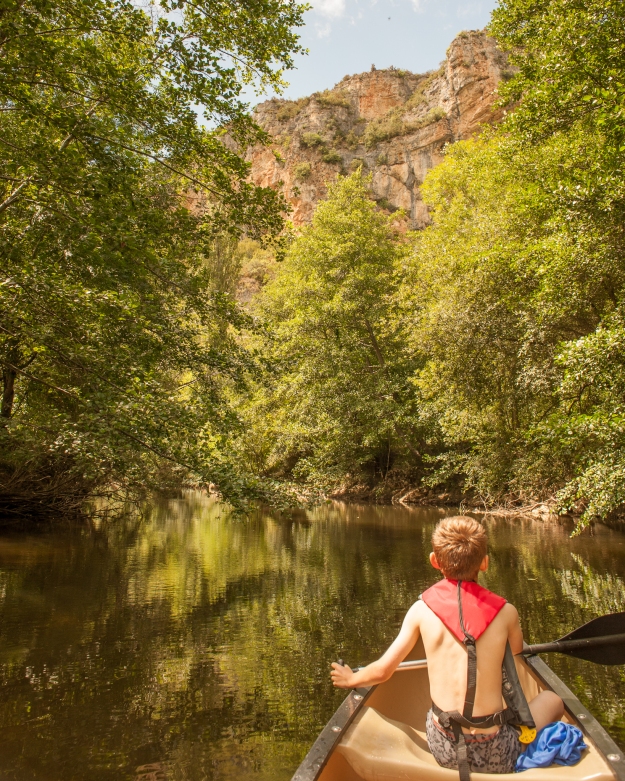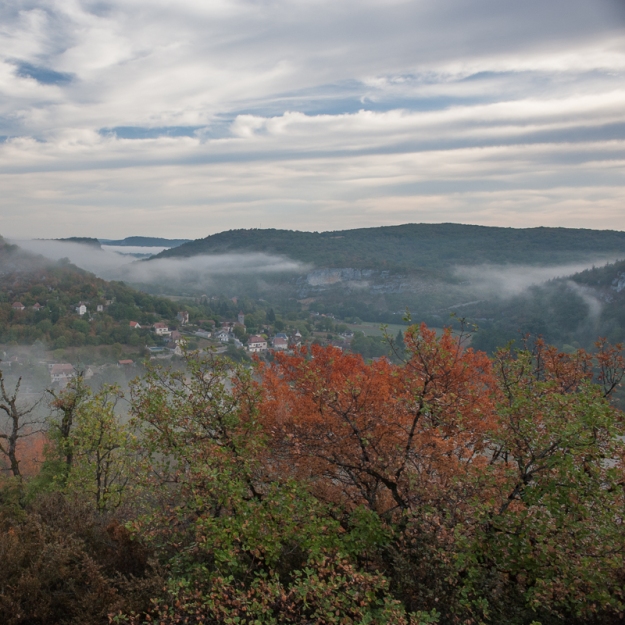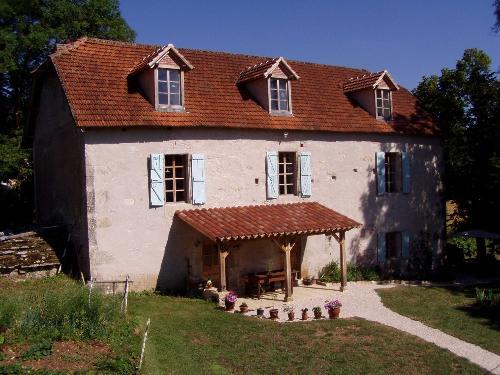In which the we canoe on the Célé for the first time.
These are some reminiscences of days on the river in the Lot region of France. I shall be mixing up stories from my first trip, eight years ago, to the trips we did last summer, about thirty trips in all. This entry is about the second day of the Célé trip, where we begin our traverse down the Célé valley.
In the morning we came down and sat around the big table for breakfast. Bread, butter, home-made jams, coffee, juice and croissants. No problem. I fielded some questions about what we are to do today. It’s simple we are going to spend most of the day canoeing. I explain that the Célé is a narrow river and we will have to take care on our steering and spend more effort on avoiding the obstructions which will present themselves. In particular we shall want to avoid the overhanging trees and any ‘strainers’ in the river. Strainers are fallen tree which can block a canoe and more dangerously trap a person underwater if they have fallen out of a canoe. This is not such a danger on this river as the flow is not that fast. However rivers can always be dangerous. I also explain that we also have a number of barrages to get past today. These are small dams which we will have to portage around. It’s only a matter of stopping and carrying the boat a few yards. Nothing drastic. Finally I mention that an agreement has been reached between the canoe outfitters and the fishermen on the river that states that canoeing is only allowed between 11am and 6pm. The time before and after being reserved for fishing. We will see fishermen outside these hours but we don’t have to make any special provision for them. I mention that no powered boats are allowed on the Célé at all.
So, if we are not allowed on the river until 11am. What to do? I suggest to the group that we will arrange to meet Didier, our canoe outfitter, at Marcilhac at 11am. He will drive us all upstream to our put-in at St. Eulalie and we will paddle back to Marcilhac. Before 11am we could go on a small walk. Everybody is up for that so I suggest we get going in 15 minutes or so. This gives everyone enough time to get themselves together and get what they need for the day. It also gives Paul and I time to get the picnic materials sorted out.
The drive down to Marcilhac would take about half-an-hour. But when the road first reached the Célé Valley opposite the village of Haut Sauliac we stopped to take photographs. The bottom of the valley was full of cloud or mist and the village floated above it. By the time we got to our destination though most of the mist had lifted. Considering how much time we had before our rendezvous I persuaded Paul to run us up to the trail head on the road leading out of Marcilhac. We would walk the trails on top of the causses and then take the trail down. I pointed out to Paul where the trail came out of the woods and spilled onto the road. Meet us here at about 10.45 I said.
Up the road Paul pulled the van over at a forestry sign and everyone piled out. Paul sped off and left us to it. A short trail led away from here on a sandy track through a stand of pines. After about twenty minutes the trail fell out of the woods into a small clearing. In the clearing was a scrubby looking box bush and behind that, as I revealed, was a Dolmen. The educational plaque next it had been vandalised and so I had to explain what this was. They are burial sites of between 5,000 and 8,000 years of age. They are usually built in a type of Pi shape with two flat stones set on edge for the sides and a large flat stone placed on top. The body and sometimes some belongings are placed inside and the whole thing covered in local materials. In rocky places this would be small stones. If soil was present then this was piled up over the Dolmen. Such burial mounds are evident over all of Europe and even in India and the Far East. In Britain when they are still covered in earth they are called Tumuli. Over the centuries the weather has exposed many of them, many of them have been robbed of any remains and often the surrounding materials have been recycled. Nobody knows who the people were who made them, or why they made them or even why they are found in the places they are. The landscape around this part of France is littered with them.
We re-trace our steps through the woods, cross the road and start on another trail. The trail is marked by a concrete table which is fashioned in the style of a Dolmen and decorated with an outline of a Wild Boar. In the hunting season the hunters rendezvous here with their dogs before a hunting expedition. It’s not the hunting season now however and we can safely be on our way. We should however remember that Wild Boar do live in these scrublands on top of the Causses. I’ve walked the trails around here many times though and only seen them twice. On both occasions it was very early in the morning. I feel sure that any boar would hear us long before we got close to them.
Walking along the trail on this sunny morning we pay attention to the kind of landscape we are looking at. The old dry-stone walls indicate that this once was farming land. I know that until the 1950s all of this land on the plateau was grazing land for sheep. None of these small trees that are here now would have been here then. All this stuff is less than about 60 years old. It would have looked very different then. Some of the land up here has been closely managed in that time and re-planted with forest trees but much of it has also been left to grow back as it will.

Looking down on Marcilhac-sur-Cele
The trail undulates along and we follow a few different types of butterflies; some Clouded Yellows, a few Blues, some Skippers and a lonely White Admiral. Before long we come to an obscured trail marker and turn a sharp right down a narrow trail. Every time I am here I think I should uncover the marker somehow as it is easy to miss. But then I don’t have the tools with me.
This new trail is the beginning of our descent down to the valley. I warn everyone that it can be steep, narrow and slippery. Be careful. As the trail narrows the box woods around become damper and covered in moss. You would think that the region up here would be quite dry, especially during the summer months, and especially as I imagine that the limestone is quite porous. For some reason though the path is damp and the moss clings to all the broken dry-stone walls either side of us. Then, surprisingly, the dampness leaves us and the trail breaks out in an almost open area where the moss is completely absent.

The Cliffs above the Cele, overlooking Marcilhac
I recognise this place now as I turn off the trail on the left and bushwhack through the open scrub. All of a sudden we find ourselves perched above a cliff looking directly down on the Célé River and the village of Marcilhac below us. It’s a toy town. We can see the ruined abbey and the huge church. We can see the flour mill and the dam and following the river into the distance we can see where we are to canoe tomorrow. We can even see our van parked underneath the trees in the village square.
Getting back on the trail we continue our descent down the trails as it zigzags down the steep hill. Every so often we catch a glimpse of the valley upstream. We cannot see the river though. After a whole series of switchbacks the trees start to become larger and greener and before long we spill out onto the road. Paul is not here so we continue our descent until we bump into him where he has pulled in off the road. He’s deduced that it is not wise to park on the road itself. Their is not much traffic but the French country drivers don’t like to hang about. It takes a mere five minutes to drive the mile or so back to the village.
Back at the village every one gets themselves ready for a day on the water. Everything they need for the river must go into a dry bag. Perhaps they need to change shoes. Eventually Didier arrives in his minivan towing the canoes. I say hello. This might be the first trip on the Célé this season so we’ll catch up on what happened over the winter; holidays, travels and this and that. We will have to make a decision about our second guide. Are you canoeing or not. If so we will all pile into Didier’s bus and drive up stream to the put-in. We are paddling back to the village for the first day. If he doesn’t want to paddle then both minibuses can be driven and we’ll split between them.

Once we are on the road Didier will attempt to stretch my French by only talking to me in French. Haha. This wont get him very far, but I like the way he does it. Didier is quite a character in this valley and seems to know everybody. From his outfitters place he helps run a place that not only provides canoes, but also climbing, mountain-biking caving and an assortment of other activities. Didier is also a musician and can often be found on a Wednesday or Thursday evening playing his guitar in a local pizza restaurant. But more of that later.
What we have to know as Didier drives in his slightly too fast way along the narrow and winding road is where we want to start our canoeing for the day. We have a choice of three places. The higher one, at Korn, gives us a very long day and is one we don’t often use. The middle one, which is nearer is awkward because you have to carry the canoes across a field and then launch from a very muddy bank. We have almost never used this since we’ve discovered the third choice which is the nearest, but which has a picnic table and a newly built ramp down to the water’s edge. This is where we will start.
When we get there Didier leaves the road and drives down a grassy track and turns the minibus around, somehow, without jack-knifing the trailer and canoes. I help him unstrap the canoes and unload them onto the grass.
I get everyone together so we can choose a suitable size of paddle and lifejacket for everyone. We choose out boats. We have decided who is canoeing with whom and I drag the boats down to the water’s edge. We are ready for take off. But first; the safety speech. Most of our guests are experienced canoeists but it is important to remind every one of certain precautions and procedures. We will have to deal with submerged rocks and overhanging trees and fallen trees; strainers. People do, from time to time, fall out of canoes, even on these simple rivers. Today we have three weirs to get past. Three short portages which can be slippery and dangerous. If we have anyone on the trip who hasn’t canoed for a while I will go over the main canoeing strokes and remind them of who does what in bow and stern. If we have children with us then we will turn all these reminders into a quick lesson and, I’ll suggest, that when we find suitable spots on the river in the first hour or so we will stop and revise some of the things mentioned here. It sounds a lot, all this talking, but it doesn’t take long and soon I’m wading ankle deep in the stream getting the first couple onboard and away. As each boat departs I tell them to canoe a little way and then to wait until we are all together on the water. Soon I am in the last boat and waiving farewell both to Didier and our other guide (if he’s not on the water with us). Otherwise we will meet a little way downstream at Espagnac.
The river is narrow this far up, and shallow too, so everyone must take care in steering a good line by avoiding the banks and following the V’s that indicate a good and deep enough channel. I will lead the way at first so we can play follow the leader until after about ten minutes or so we come to a wider pool and I can turn into an eddy.
When I slip into a deep and wide pool with eddies on either side I spin out and ask the others to do the same and tuck in behind me. Sometimes this can be a bit chaotic but eventually we are all in the eddy and ready for some instruction. I explain about the speed of the water and how we can see how fast the water is moving in the centre of the river and with quiet pools either side where the water is slow, if not stationary. We can use these differentials in speed to help us both stop our canoes and turn, if we wish.
If, when coming down fast water we turn the bow of the canoe into slow water – and I point out that the line between the two can easily be seen – then the nose of the canoe will be braked by the slow water and the force of the fast water will push the stern of the canoe around until the canoe is facing upstream and we can paddle forward into the eddy itself.
This ‘Eddy Turn’ is a very useful manoeuvre and is not only a way of stopping and taking a rest as we are doing now but is an important way of stopping in the midst of a busy rapid so that we can take a rest and check the way ahead before starting off again.
I then mentioned that the opposite movement was ‘Peeling Out’ and in this situation we poked the bow of the canoe out from the slow water, as we face upstream, and into the fast current and the force of the water turns the canoe around until we are moving downstream in the current.
We should practise these techniques where we can as we canoe the next few days and use the slow pools and eddies to stop at every opportunity. Just downstream from here I said is the bridge to the village of Espagnac, we will go under the bridge on the river right and then eddy turn onto the beach on river left. We shall be leaving our canoes on the beach for a while as we walk around the village. Let’s try the Eddy Turn there and don’t think about simply scooting under the bridge on the river left and running into the bridge as it is far too shallow and is often blocked by fallen branches anyway.
Before we leave however we should practise another manoeuvre called the ‘Upstream Ferry’ or ‘Front Ferry’. This technique is designed so that we can cross from one side of the river to another without going any further downstream (or upstream for that matter). This is very useful in a long rapid if the obstructions presented to you mean you have to quickly change sides. The only disadvantage is that you have to face upstream to do it and this probably means you need to eddy out first, before ferrying over. I pointed out that a more advanced technique the ‘Downstream Ferry’ or ‘Back Ferry’ does exist but this requires an extra level of ability. Learn the upstream version first and get competent in that before attempting the downstream version.
To begin the ‘Upstream Ferry’ we naturally need the canoe to be facing upstream, which it would be if we have just done an eddy turn into the quiet water. When tandem canoeing we need the bow paddler to have his paddle on the upstream side and the stern paddler to have his on the downstream side. Each paddler has a separate job.
The bow paddlers job is to canoe forward with just enough energy and force that the canoe is neither pushing upstream or being pushed downstream. The stern paddlers job is to maintain the angle of the canoe to the current at approximately 30 degrees. In this way, much as a yacht tacks against the wind, the canoe will progress across the stream without forging forwards or drifting backwards. When the other side is reached the stern paddler can release the angle he has been holding so that the bow of the canoe rotates around until the canoe is facing downstream and the pair can continue on the side of the river they want to be on.
It sounds complicated but after a few demonstrations and after a few criss-crosses of the river everyone has got the hang of it. If you are canoeing solo then of course you have to do both jobs; keeping the angle and the correct pace. At first it seems difficult to keep the correct angle, which depends entirely on the force of the river, and the forward paddling in balance. The canoe moves sideways across the stream very easily and the amount of forward paddling can be much less than expected.
We spend twenty minutes or so here before we peel out for the last time and continue on or way. It’s not long before we get to the bridge and as I expected the bridge has captured some fallen branches on the left hand side and we have to negotiate the shallows, the rocks and the quickening water as it passes under the rightmost arch before doing an eddy turn into the shallows and hopping out on the beach. Everyone does this in quite good style which is just as well because if you miss the turn the river doesn’t have a good place to stop for a few hundred yards.
We drag the canoes up onto the gravel beach, ditch our lifejackets and grab our cameras and things from our dry bags. We will leave our stuff here whilst we go for a short walk around the village.
First though we will examine the strange behaviour of a cloud of butterflies which are fluttering about by a shallow pool and collecting on the damp sand in quite some numbers. I explain that the butterflies are ‘puddling’ which is a way for them to extract minerals and amino acids from the damp sand or soil. Many species do this. Today we can see two large types of butterfly here which are generally black and cream, or black and white or black and yellow. These are Europes only Swallowtails. The stripes of the Swallowtail are at right-angles to the body whilst those of the Scarce Swallowtail are parallel to the body (approximately). The tails of the Swallowtails can be seen clearly. These are thought to disguise the tail of the butterfly to look like the head. They have eye-spots here and the tails represent the antennae. Birds are said to attack the ‘wrong’ end and the butterfly can make an escape. These are Europes largest butterflies too.
Also puddling are many ‘blues’. When I’ve looked closely before they are usually Common Blues or Turquoise Blues. Blues are quite hard to differentiate though. I usually wait until I can get home and compare the photograph with the guide book. Sometimes other butterflies are here too.
After amusing ourselves trying to photograph the butterflies we move off and climb the sandy path up to the road. We can see that the village is called ‘Espagnac St. Eulalie’ which allows me to explain that immediately after the French Revolution at the end of the 18th Century it was decided that to reduce the power and influence of the Catholic Church and as a paean to Secularism all saints names would be removed from village names. The village was called St Eulalie, for reasons which will become apparent in a moment, and it was renamed Espagnac which I presume was a local name hereabouts anyway.
You can imagine that contrary to such a diktat the locals continued to use the name they had always used no matter what the new sign said. So in time both names came to be used which is why it has the double name we see today. These types of names can be seen all over France.
We continue our short walk into the village admiring the faded pale yellow limestone houses which has worn to lichen covered grey. The walls are draped with brightly coloured flowers; trumpet vines and roses and pelargoniums. If it spring then irises will be in flower where they sprout from the tops of walls and all manner of wild flowers will be crammed into all the spaces.
On turning the corner we will come to a cast iron gate which leads into the church grounds. The church is looming above us and we can see the large arched window overlooking the apse. Opening the gate we go inside and walk down the path past a couple of buttresses to the main entrance; a large dark wooden door down some curved steps. It is often locked, but from time to time it is open and you can go inside. A notice advise that a neighbour has a key and you go and fetch it if you want to. I rarely do and merely rely on happenstance. The churches in this valley, they are all Roman Catholic, cannot afford to have a Parish priest each these days and a single priest will look after a half-a-dozen churches up and down the valley. This church will see a service every month or so. The bells will still be rung, however. On the hour and every hour with a special chime for Mass (Angelus), usually at 7am. I imagine that these days the bell-ringing is automated.

Inside the Church at Espagnac
The inside of the church is very ornate and surprisingly light and airy. It is heavily decorated and has many statues it’s always a wonder to be in here.
Outside again the path leads on to a small cemetery and to the left a tall broken wall. This is part of the remainder of the Abbey that was once here. We shall have to go around the other side to get a better view. So returning to the road via the gate we continue down the only street past a couple more cottages and the ‘Maires’ office. Some posters are stuck on a board here to advertise local events. The most common seem to be village fairs with bands and feasting. A map is painted on a sign here too and on closer inspection it tells us that we are on the Compostella, the ‘Way of St. James’ and a pilgrim route that would take you all the way to Santiago de Compostella in Spain.
If you step back into the road you can get a glimpse of the clock tower of the old Abbey. A rather odd construction of wood and what seems brick. Again we will have to go around the back to see it properly.

The Belfry of the Monastery at Espagnac
Further down the street we come to an arched gateway which leads into an area which has a slightly cloistered feel. This is in fact the ‘Gîtes d’Etape’, or hostel where the pilgrims stay. I have stayed here myself in the past. After the arched gate on the right is a large bunk room and on the left is a steep staircase to numerous single and double rooms. Further on the left is the doorway to the kitchen and dining areas. Everything is beautifully archaic and medieval. The doorways are all arched and rather low, but the facilities are up-to-date and clean and it can get busy here in the summer.
Walking on further you pass another cottage on the left whilst on the right is a broken wall. Eventually you turn right and come into the courtyard of the old Abbey. Finally you can see the strange tower in all its glory and in front of you the remains of a double row of cloisters. Sometimes in the summer a small cafe is open here. A public toilet is also available.
The open grass in front shows how large the Abbey must have been. In its heyday of the 13th Century their were Nuns here and up to 100 Augustine monks. The Abbey was abandoned some time after the revolution.
On the edge of this patch of grass is a wall and behind that wall is a small vegetable garden. I always like to peak over the wall to see how they are getting on. It always seems to be immaculate and yet I never see the gardener.
Returning to the main road we can look at the building opposite and to the right which appears to be a sort of community hub. I’ve seen various exhibitions in this space. Once it was posters and pictures depicting various stages on the Way of St. James. More recently it was some information on the re-introduction of the growing of Saffron from a particular type of Crocus. They were selling some saffron products too but sadly we were usually here on a Sunday and the place was invariably closed.
Opposite this place is a rather vulgar statue, it must stand two metres high, of a pilgrim. Not much to say about that. Several of the lintels above the doors around here are also decorated with a scallop shell which is the accepted symbol for St. James and the pilgrimage.

Golden Pheasant (Chrysolophus pictus) at Espagnac
If you sneak into the property just here, which I presume is private, then you will discover a large bird cage. Inside is a pair of Pheasants. But these are not your everyday pheasants, but Golden of Chinese Pheasant. The male is spectacular: he has a golden head with a tiger striped ruff, and bright red chest with a bright green and black nape and luminous blue wings, a yellow back and a very long gold and brown speckled tail. Quite the handsome beast.
So after this little diversion we return to the canoes to continue on our way.

Back at the beach we get ourselves together again. Stuff is stashed in the dry-bags and the lifejackets are put back on. Looking at the river it is obvious that we have to canoe through some small rapids. Little more than a riffle really. The good news is that the run through the rapid as it takes a bend in the river is straightforward and a line of neat Vs (pointing downriver) lead the way. We shall have nothing complicated to do. Just stay in the middle of the stream. Head straight through the Vs and mind the boulders.
Each canoe in turn paddles out from the beach in an upstream direction and then peels into the main current before turning downstream. Every one has given themselves enough room to do this and I follow last of all. If I hadn’t be comfortable about everyone I would have gone first to lead the way and then eddy turned beyond the riffle to watch every one coming down. When all the guests are confident like this then I can sweep down the river behind them. Though I generally move up and down the line just to have a chat and see how they are getting on.
I remind them that the person in the front has to make the decision about the direction to take and has to calculate where the deeper and fast water is, and sometimes make a decision between the lesser of two evils. The advantage though is that the front boat gets to see the wild-life.
As usual we will see the Wagtails (usually Grey and Pied, but occasionally Yellow). We can easily recognise the swooping undulating flight and the characteristic wag of the tails when they are walking on the water’s edge. Where the water is slightly more rough we may also see the Dipper which is a round Robin-like bird which is black with a white chest. They too like to feed on the insects in the water. They are said to dip right under the water at small cascades but I’ve never seen this.
In recent years we have seen more Sandpipers on the river. These fly off in a little flurry with a straighter flight than the Wagtails and Dippers.
As we negotiate the bends and turns I push myself to the front of the flotilla and remind the current leader that we have three small barrages to cross today. Each of them will require a small portage of a few yards. Each of them will be portaged on the right. Be careful when approaching them and when sliding the boat over be especially careful as the rocks are slippery. Also, I said, we will be taking a break after the second one as that is where we are having lunch.
The bird that everyone wants to see is the Kingfisher and we are usually lucky enough to see them. Although only small on a sunny day the blue flash as they fly away, in a direct and straight flight, often only a foot or so above the river, gives them away. The metallic blue really does catch the light. Often we push a Kingfisher, or sometimes a pair, downstream in this manner. I’ve been told that each pair has a mile or so of territory. If we push them downriver far enough then they will either cut across a bend in the river to get past us, fly high into a tree and wait for us to go by, or, more rarely fly back over our heads. When they do this we get a glimpse of the orangey red belly of the bird. It seems to me that on the Célé the Kingfishers are quite shy as you can never seem to get near them, whereas on the Dordogne you get closer to them. Perhaps they are more used to humans in canoes.

Before long we approach the first barrage and I slip ahead to get my boat out of the water and out of the way. I can then help the others as they come one at a time. In a short while we are all past the obstacle and after a quick stretch of the legs we get going again. This place in the Moulin Vieux, a popular camp-site in the height of summer. I remember watching a World-Cup football match here a few years ago on a big screen in a Marquee. But on we go today; we’ve a lunch waiting for us.
The river continues in its quiet way. We dodge the shallows and negotiate the little rapids where the stream speeds up. In the deep pools we can see small shoals of fish beneath us. We can recognise the vertical stripes on the Perch, the yellowish fins and feelers on the Barbels (which are like a catfish) and sometimes we can recognise the green colour, with a reddish stripe, and the red tinged fins of the Rainbow Trout. The fish are impossible to identify when they are small though.
In time I will notice the road bridge at Brengue approaching and warn the others that we have the second portage coming up. After passing the bridge we forgo the new ramp built into the bank on the right and slide under a Weeping Willow to approach the barrage on the right side. The barrage is merely a collection of large rocks which has been placed across the river. As far as I know it doesn’t represent the site of an old mill like the previous barrage. I think it was built to provide a deep pool for children to swim in and perhaps a place for fishermen. In any case after a bit of work and some slippery moments we manage to get all the canoes out of the water and up onto the bank. Side-stepping the stinging nettles which sometimes grow here we manhandle, carry and slide the boats down to the beach so that they are in place after lunch. Who mentioned lunch? Steve is here, with the van and has already started setting out the lunch on a picnic table under the trees. This is a Municipal Campsite and I tell everyone where the bathrooms are. This place has great facilities.
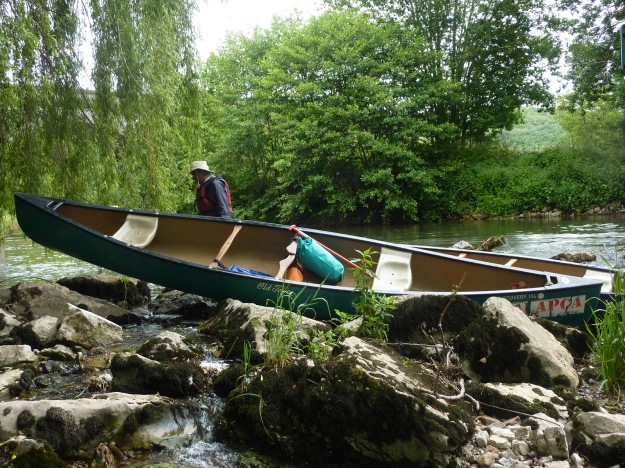
Steve hauls a canoe over a weir
I can now help Steve get the lunch prepared, starting with a nice glass of wine and a quick wash of hands with that chemical stuff. In no time at all the picnic was laid out. Good fresh bread, many different cheeses, some dried sausage, a pate, some hame and lots of chopped vegetables and salad. With pickles and mustard and cool water and plenty of wine it was a feast. Plenty of fruit too, and perhaps a taste of chocolate to finish off. And then, perhaps, a little nap.

When everyone is sufficiently rested then we pack away the picnic and stroll down to the beach to get back into our canoes. We have one more barrage to get past and I estimate it will take us another hour or perhaps ninety minutes to get there. We have plenty of time and are in no rush.
The afternoon paddle is much as before. Without disturbing the Mallard ducks too much, who often seem to be trailing little families, we cruise down the river changing sides when necessary to avoid the water that is too shallow and taking the quicker current where we can. Mostly it is easy work and we can enjoy the sun and cool off by dragging our hands, and sometimes, our feet, in the water. Every now and again we have to pay a bit more attention as they river gets narrow and pushes us quickly. Some of these places have light hazards in the way of overhanging trees and bushes. In particular you don’t want to become entangled in a wild rose bush.
Most of the time the river has trees either side and the road is not close to us. As the river sweeps in large turns we see the white limestone cliffs of the valley. First close on this side, and then the other. We don’t pass very many buildings at all, although if you are keen eyed you can catch a glimpse of the troglodyte houses which are built into the cliffs high above us. These are the types of houses which uses the cliff-face itself as the back-wall of the house. It seems that it would be impossible for a road to reach them, but I’ve walked up there and they do indeed have small tracks leading up there. They must have spectacular views up and down the valleys. I just wouldn’t want to be a window cleaner.
As we mostly drift down we raft up together in places for a small chat. The fish can be seen clearly when we drift over shallow pools. They flash away from us like underwater ghosts. We keep seeing the usual birds. From time to time we approach a heron, but they always flap away before we reach them. These too we push down the river until they deign to go back over us or stand, gangling and high in a tree, to let us slip by underneath.
The trees on the banks are of numerous species, though the most common are Black Poplars and White Poplars, Alders and Aspen, with White Willows from time to time. In the spring and early summer you can tell when a Lime (Linden) Tree is passed as the scent of its flowers wafts very strongly over the river. Another tree that flowers prettily at this time of year is the False Acacia whose white flowers drape in long trails over the water. You will also catch the May Blossom from Hawthorn bushes too.
A variety of birds will cross the river as we go down. Plenty of the crow family for example, including the colourful Jay with its flash of pink and electric blue. Sometimes a Green Woodpecker will cross – looking all the world as colourful as a parrot; luminous green with a very bright red head.

Bridge and Willow on the Cele
Before long we are coming under the bridge at St. Sulpice and approaching the last barrage of the day. Sometimes, early in the season the river has enough water that a route can be found, towards the left, where it is possible to canoe through. It’s always a bit bumpy though. Generally it is easier to coast up to the corner of the barrage and disembark. I go first and drag my canoe onto the rocks. I can then grab the other canoes, help people get out. It is slippery, and then get them to walk around to the other side of the barrage. I can then slip the empty canoe (though it is still carrying the bags and paddles) over the rocks so it slips into the pool below. The guests can then catch the canoe and either prepare to go on down river or pull over for a short break. It is easier shooting the canoes over like this than it is to manhandle the canoes around the obstacle. It’s more fun too.
If it the height of summer and hot enough we can take a break here for swimming. If you are of a mind then you can climb in amongst the rocks and lower yourself into the surf and get yourself a very pleasant shoulder and back massage. If your limbs are tired from canoeing, perhaps if you haven’t done it for a while then this can be great fun. The river is very strong though so you must be careful not to be swept away and you must avoid getting your feet trapped in the rocks.
The afternoon is probably wearing on by now so I encourage everyone to get their skates on. If I mention that Marcilhac has a lovely cafe with cold beers waiting for us then I usually have little difficulty in persuading people that it is time we were off.

We have about another hour of canoeing to reach Marcilhac. It’s smooth sailing all the way home and noticeable that the river is slowing down. This is because the river is dammed at Marcilhac where a water-mill is in operation. The river is backed up behind this dam and this becomes at lot more noticeable the closer we get.
The river is still turning in large bends and the limestone cliffs are getting closer on this side, and then on the other. The only surprise in store for us is a place on the river where an underground chamber opens out. Several times when passing here I’ve been astonished to notice some bubbles seeping up from below and then been shocked to see a surfacing scuba-diver. Apparently you can swim into a cave from here for a kilometre or so. We often see a group of wet-suit clad divers getting themselves prepared on the bank. Just occasionally we almost run one over.
The last bend of the day brings us past a camp-site on the right bank where a blue punt is always tied up; it’s ‘Philippe’! The water is sluggish now and it’s the end of a long day but finally we round the bend, taking the outside, as it’s shallow and muddy on the inside, and get to the pool above the Marcilhac Dam. A grassy bank is on our left and we turn towards it before driving our canoes ashore.
Steve is here to help us and we drag the canoes to the corner and flip them over. We will return here tomorrow to continue our journey downstream. Meanwhile we load our paddles and lifejackets into the van. If necessary we can change our clothes and boots and then we can head towards the cafe.
We’ve been coming to this village for some years now and at one time we used to stay in a Chambre D’hôte in the village and have dinner at Madame Pierette’s place. She cooked a wonderful dinner. No menu, you ate what you were given. More especially you have to finish each course before the next would come out. The number of times I had to make my way through a mountain of roast potatoes. Our schedule doesn’t allow to have dinner here any more, which is a shame, and she no longer has the energy to do lunches, except a Sunday lunch occasionally. I shall have to make a special effort to get to one of these lunches one day soon.
Meanwhile we do make sure that we visit here for drinks after a day on the river like we have just finished. It’s always fantastic to roll up and surprise everyone and they never know when we shall turn up. If it’s the first trip of the year, or the last then it’s always a special occasion. Everyone has a hug and we sit on the rickety white tables underneath the shade provided by a grape vine. Madame Pierette will then bring over a vast tray of assorted beers and wines for everybody. It’s a fabulous way to round of an a day on the river.
Imagine my horror then when after loading and locking the van I began to stroll over to the cafe when I noticed everyone had gathered in the bar opposite Madame Pierette’s place. What to do. Drinks had already been ordered. I had to sit down with them and hide myself from view from the cafe opposite. I had to explain and I had to make everyone promise that we would cross the street when our first beer was drunk. It was a disaster. I was so embarrassed. Worse I caught out of the corner of my eye that the daughter of Madame Pierette, Cecile had seen me. I was mortified and ashamed.
After ten minutes of squirming and shifting in my seat I managed to get everyone across the road to the correct bar. Madame Pierette was of course as lovely as always. She probably hadn’t even noticed. But Cecile was relentless in her taunting of me. She would never ever let me forget. Even if I did notice a small wink in her eye. All the guests were of course terribly amused by the faux pas. In any case it was no hardship to have a second beer. I had to have a third beer to calm my nerves.
Fairly soon it was time to leave and after even more hugs and kissed cheeks we managed to leave and pile back into the minibus for the short twenty minute drive back to the farm-house.

We bounce down the Célé Valley road until we reach the bridge at Sauliac which we cross and then take the narrow road that climbs the side of the cliff. Across the valley we can see both the low and the high villages of Sauliac. The road wends its way up passing a tiny road that leaves back down to the river; this leads to the Chāteau de Géniez, a mysterious place which can neither be seen from here, above it, or even when you canoe right past it on the river.
When the road gets to the top of the cliff and has reached the Causse it leaves the valley. Shortly we arrive at a junction where we must turn right through a small wood. The road becomes even narrower now and has tufty pieces of grass growing in the middle. Eventually the road breaks out of the woods with fields on either, with perhaps a sheep or two. If you look closely you will notice that the sheep have strange black eyes. That’s the way they are around here.
Passing another junction where a road comes in from the left we continue on until we come to the hamlet of Aynac. No more than a small collection of farm houses. But we are not there yet and we must continue again down a short hill where we pass more sheep on the right and a smart market garden on the left.
The roads turns right and in a few hundred yards as we rumble past the hedges we finally arrive back at La Métairrie Basse, Helen and Richard’s place. Everyone bundles out of the van and grabs there stuff from out of the back. Depending how late we are, and what the weather is like, we will be able to spend an hour or so at the pool before getting ready for dinner.
Richard has converted one of the old barns into a small swimming pool which is cunningly hidden away. A gate through the old wall of the stone barn leads into an enclosed space, with the barn roof long gone; this is where the pool is. It’s small of course but just big enough to cool off after a long hot day. There are some tables and chairs up here too so it is also possible to relax and read and have a bottle of beer.
Either before or after using the pool Steve and I will find some time to clean up our picnic dishes and put away our food in the fridge. We’ll try to not get in the way of Richard and Helen working in the kitchen. Usually by this time dinner has already been prepared and is bubbling away in the oven. We’ll try to make a guess about it can be.
After that we’ll take a quick shower and then be ready downstairs for a pre-prandial drink with our hosts. Generally that means Richard. He will offer us some of their home-made drinks; perhaps a Vin Noix, a Ratafia or a Fénelon. Everyone soon joins us as we make ourselves comfortable on the sofas and armchairs. If it high summer we may be sitting outside, but if it’s autumn time then we may be sitting cosily with a small fire going.
The conversation will generally turn to the farm house and Richard will patiently tell the story of how they came to be here and how they worked together to re-build from the ruins they found. It’s a good tale and Richard is entertaining as he tells it, even if he does resemble a slightly sinister Blofield as he holds one of his beloved cats. They are both quite mad about cats and I suppose living out here in the wild they do have their uses.
In time Helen will call us to dinner and we will arrange ourselves round the large dining table. We will then enjoy a splendid three course dinner that has been home-made and very likely includes vegetables from their own garden. Every evening I have stayed here has been a simple pleasure. Plenty of wine and easy conversation. From time to time we have other guests too, not on our canoe trip, but often guests that are walking the Way of St. James, or least a section of it. This always adds an extra dimension to the conversation.
At the end of the meal, perhaps after a fiery Eau de Vie, which has been distilled locally we will retire back to the armchairs, or, more often than not, slip away to bed. It’s been a long day and we will have more of the same tomorrow.



